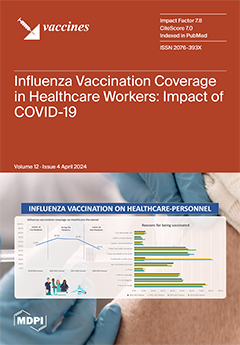In the realm of antenatal care, vaccinations serve as a cornerstone, crucial for safeguarding the health of both the mother and the fetus, while also extending protection to the newborn against communicable diseases. Nevertheless, vaccine adherence among pregnant women remains very low. The
[...] Read more.
In the realm of antenatal care, vaccinations serve as a cornerstone, crucial for safeguarding the health of both the mother and the fetus, while also extending protection to the newborn against communicable diseases. Nevertheless, vaccine adherence among pregnant women remains very low. The aim of our study was to evaluate the uptake of vaccines (influence, pertussis, and COVID-19) among women during pregnancy and to understand pregnant women’s knowledge of vaccines and the diseases they protect against. The purpose was to investigate the reasons why pregnant women chose not to be vaccinated and to develop effective strategies for informing them about the importance of vaccination for both maternal and fetal safety.
A prospective observational study was conducted in the Department of Obstetrics and Gynaecology, “Ospedale Santa Maria della Misericordia” in Udine, from 1 December 2021 to 30 June 2022. During this period, a self-completed paper questionnaire was administered to women at the end of pregnancy or during the puerperium. A total of 161 questionnaires were collected. Higher educational level was found to be significantly associated with influenza vaccination uptake (
p = 0.037, OR = 2.18, 95% CI 1.05–4.51). Similarly, for pertussis vaccination, adherence was mainly associated with higher educational level (
p = 0.014, OR = 2.83, 95% CI 1.24–6.47), but also with Italian nationality (
p = 0.003, OR = 3.36, 95% CI 1.56–8.43) and pregnancy attended by a midwife or private gynecologist (
p = 0.028, OR = 0.39, 95% CI 0.17–0.90). Regarding the COVID-19 vaccine, the only factor positively influencing uptake was Italian nationality (
p = 0.044, OR = 2.66, 95% CI 1.03–6.91). Women’s fear that vaccines would endanger the fetus appeared to be the most important reason for refusing vaccinations. Simultaneously, patients also exhibited a desire to receive more information about maternal vaccination, particularly from their general physician or gynecologist. For this reason, it is imperative to enhance maternal vaccination counselling, making it a routine step in prenatal care from the first antenatal visit until the postpartum period.
Full article






